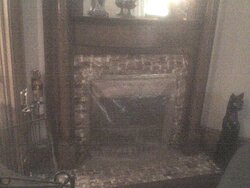I have to decide what to do with my 1900 fireplace insert:
I live downtown in Colorado Springs CO in a 1900 house about 2600 s.f. and it has an open coal/wood fireplace ("Echo Grate #422 Pat. 7/4/1893) in the corner of an interior wall with a wood mantel above and wood columns on the sides from floor to mantel, in the living room. The insert has a bottom grate and ash drop under it that drops into a large capacity cleanout in the basement.
The problem is that the times I've buned wood or coal, it seems too much of the heat goes up the chimney, barely heating the room much less any adjoining rooms, and it seems to burn/consume fuel fast. So I just don't use it.
My furnace is natural gas and gas is cheap then other states but going up and I think I can accumulate some free wood during the summer and don't mind cutting or splitting too much and have a small pickup truck. I'm waiting for an answer on how to obtain wood in our local national forests and the permit cost involved, as this may be a very cheap wood source, and I'm checking with the city to see if they provide low cost wood from street trees etc.
Wood bought here is about $200 a cord and coal about $170 a ton.
We basicly don't have any restrictions on burning yet in our town.
The chimney is 10" square made out of brick, and I know if I get a new insert that I need to use a round stainless steel insert in the chimney and a cap. I know it will cost me about $2000 or more in parts. I know not to get an insert with the old unreliable catalyst design.
Q. I know modern inserts are 70% or higher efficient, how efficient is my old insert, in that will I see a lot more heat with a modern insert for the same amount of fuel or is the old 1900 insert not that bad? Will it burn/consume slower?
Q. I'm having trouble finding a new insert that will fit well because the fireplace is 25 1/2" wide, 30" tall, 15" deep, and the wood mantel is only 8 3/4" above the fireplace and 10 1/2" to the sides of the fireplace. Do you know of any brand inserts that will fit well?
Q. I'd like to be able to use the 9" x 4" ash drop still if I get a new insert, am I asking too much?
Q. I know the inserts are not rated for coal, but I'd like the option depending on fuel prices and I like the long burn of coal and compactness. Our power plants burn coal and I've read there is 300 years left and very abundant. I've been told by an expert to get an insert with a grate bottom to give air to coal so I can burn coal if I choose to, that the manufactuers don't rate them for coal but it is ok if one doesn't put too much in, but all the inserts seem to not have a grate bottom. There's only a few models rated for coal/wood and they are for anthracite coal and we have the softer coal here from CO/WY. Do you know any models with a grate bottom?
Q. My other option is a gas insert but then I can't burn scrap wood and what if the prices go up. What is your guess on the future outlook of prices and laws and availability of wood/gas/coal?
Q. I've read that an insert that gets it's combustion air from outside is better because there's no cold air vacume infultration but since my chimney is in an interior wall can I still get outside air? I see natural gas can have two inserts up the chimney, one for the combustion air and one for the vent. Can I get the combustion air from the chimney for a wood insert, or can I get it from going through the basement and then the side of the house like a cloths dryer vent or just don't use outside air?
Q. I know coal ash has heavy metals but is it best to throw ash away wood or is it useful for anything like in flower beds etc?
THANK-YOU FOR YOUR ANSWERS/TIME!
I live downtown in Colorado Springs CO in a 1900 house about 2600 s.f. and it has an open coal/wood fireplace ("Echo Grate #422 Pat. 7/4/1893) in the corner of an interior wall with a wood mantel above and wood columns on the sides from floor to mantel, in the living room. The insert has a bottom grate and ash drop under it that drops into a large capacity cleanout in the basement.
The problem is that the times I've buned wood or coal, it seems too much of the heat goes up the chimney, barely heating the room much less any adjoining rooms, and it seems to burn/consume fuel fast. So I just don't use it.
My furnace is natural gas and gas is cheap then other states but going up and I think I can accumulate some free wood during the summer and don't mind cutting or splitting too much and have a small pickup truck. I'm waiting for an answer on how to obtain wood in our local national forests and the permit cost involved, as this may be a very cheap wood source, and I'm checking with the city to see if they provide low cost wood from street trees etc.
Wood bought here is about $200 a cord and coal about $170 a ton.
We basicly don't have any restrictions on burning yet in our town.
The chimney is 10" square made out of brick, and I know if I get a new insert that I need to use a round stainless steel insert in the chimney and a cap. I know it will cost me about $2000 or more in parts. I know not to get an insert with the old unreliable catalyst design.
Q. I know modern inserts are 70% or higher efficient, how efficient is my old insert, in that will I see a lot more heat with a modern insert for the same amount of fuel or is the old 1900 insert not that bad? Will it burn/consume slower?
Q. I'm having trouble finding a new insert that will fit well because the fireplace is 25 1/2" wide, 30" tall, 15" deep, and the wood mantel is only 8 3/4" above the fireplace and 10 1/2" to the sides of the fireplace. Do you know of any brand inserts that will fit well?
Q. I'd like to be able to use the 9" x 4" ash drop still if I get a new insert, am I asking too much?
Q. I know the inserts are not rated for coal, but I'd like the option depending on fuel prices and I like the long burn of coal and compactness. Our power plants burn coal and I've read there is 300 years left and very abundant. I've been told by an expert to get an insert with a grate bottom to give air to coal so I can burn coal if I choose to, that the manufactuers don't rate them for coal but it is ok if one doesn't put too much in, but all the inserts seem to not have a grate bottom. There's only a few models rated for coal/wood and they are for anthracite coal and we have the softer coal here from CO/WY. Do you know any models with a grate bottom?
Q. My other option is a gas insert but then I can't burn scrap wood and what if the prices go up. What is your guess on the future outlook of prices and laws and availability of wood/gas/coal?
Q. I've read that an insert that gets it's combustion air from outside is better because there's no cold air vacume infultration but since my chimney is in an interior wall can I still get outside air? I see natural gas can have two inserts up the chimney, one for the combustion air and one for the vent. Can I get the combustion air from the chimney for a wood insert, or can I get it from going through the basement and then the side of the house like a cloths dryer vent or just don't use outside air?
Q. I know coal ash has heavy metals but is it best to throw ash away wood or is it useful for anything like in flower beds etc?
THANK-YOU FOR YOUR ANSWERS/TIME!



